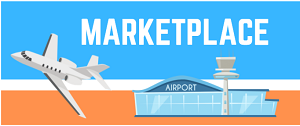Commercial airline service is in a retrenchment mode, thanks in part to pilot shortages, particularly at the regional carriers, and reduced demand for service, especially at airports serving small communities.
A case in point is Del Rio, Texas (DRT), which will lose its only airline service this spring with the pullout of Mesa Airlines, American Airlines’ regional partner. American has also announced plans to end Mesa-operated service to Columbus, Georgia (CSG) and Long Beach, California (LGB)—although those locations will continue to be served by other carriers.
These are hardly isolated cases. According to statistics provided by the FAA at the request of the Aviation Business Journal, 576 airports in the US—including Alaska, Hawaii, Puerto Rico, and US territories—had scheduled airline service in February 2020. Of that number, 301 saw service reductions, including 24 that lost service completely between February 2020 and February 2023. Over the same timeframe, 104 of the airports had “significant” scheduled service reductions, which the FAA defines as 50% or more. The numbers are based on the average daily scheduled flights by commercial passenger carriers for all US airports.
Even the Essential Air Service (EAS) Act subsidy is no guarantee that scheduled airlines will continue to serve an EAS airport, as Adam Cowburn, managing director of Alton Aviation Consultancy in New York, explained. EAS, he pointed out, was created by Congress in the wake of airline deregulation in 1978 to subsidize unprofitable airline service in some markets. Slated to sunset in 1988, EAS is still in force, with $400 million in funding in 2022. According to the latest Department of Transportation (DOT) statistics, 110 airports in the continental US were listed as EAS points as of December 2021.
“Subsidies have increased despite the introduction of smaller and more fuel-efficient aircraft, which should help drive down operating costs,” he said. “But that hasn’t stopped airlines from pulling out of EAS markets.”
For example, Cowburn noted, United Airlines regional partner SkyWest cut nearly 30 destinations covered by EAS in 2022, including Decatur Airport (DEC) in Illinois and Virginia’s Shenandoah Valley Regional Airport (SHD). “In many instances, however, (reduced) service to airports, including those supported by EAS, has been driven by regional airline pilot shortages,” he stressed.
As the dynamics driving these trends continue, the logical question is to what extent can the vacuum left by the airlines be filled—and the answer may come from the business and general aviation (B&GA) community. To start with, lack of airline service has been cited as just one reason why companies that can afford them have established in-house flight departments.
One example is a large, Midwest-based transportation and logistics company that currently operates two Cessna Citation XLS+ jets, transporting company staff ranging from senior executives to lower-level management. According to Doug Kelley, the firm’s director of corporate aircraft, the two jets made trips to 61 airports during a recent three-month period, and only 21 of those airports offered airline service.
“We had a trip on which seven people were flown out and back within a day,” he said. “Had they gone by airline, it would have been a two-day trip with added hotel and meal costs, in addition to airline tickets. Industry-wide, I see increasing use of private aircraft, not only due to airline cutbacks, but to airline reliability, as well.”
Nonetheless, Kelley cautioned that even corporate aviation is not immune to a pilot shortage, currently the result of airline hiring. “It is a problem for the corporate aviation community. In fact, our company had to increase pay to retain pilots,” he remarked.
Of course, not all companies or high-net-worth individuals can afford to buy and operate a private jet. This is where charter could present a growth opportunity, particularly in private, ad hoc charter.
A private charter takes place when an individual contracts with an operator to fly to one or more airports on a prearranged day and time of the customer’s choice. Legally, the operator must be a certificated direct air carrier under FAA Part 135 regulations, which pertains specifically to aircraft with 30 passenger seats or less.
Often, the trips are flown by business aircraft management companies that hold Part 135 authority. By putting an aircraft under a charter certificate, the aircraft owner has the opportunity to realize a revenue stream during a period when the airplane is not being used.
Private charter, currently a growth market, was boosted largely by the fear of flying commercial during the teeth of the pandemic. Using charter activity data for DeKalb-Peachtree Airport (PDK) near Atlanta as an example—generated by Argus, but provided to the Aviation Business Journal by Alton Aviation Consultancy—charter accounted for 9,311 flights in 2019 from that airport. By 2022, the number reached 10,660—a 15% increase. For the same period, charter flight hours—11,733 in 2019—increased by 23% in 2022 to 14,442.
“Without a doubt, COVID caused a clear surge in people flying privately. This included cities that were well-served by the airlines, but especially those that are underserved,” said Andy Priester, chairman & CEO of charter operators Priester Aviation & Mayo Aviation. “Even pre-COVID, airline operations under EAS had been gradually declining, so there is definitely a need and desire in smaller cities for greater connectivity.”
Priester noted that at the time he was interviewed by the Aviation Business Journal, he was in a “popular smaller destination city” preparing for a meeting with city leaders. “After losing their airline service, they are exploring how we may help them provide service,” he said.
Priester was asked if private charter has, in fact, the potential to be an airline replacement in smaller communities.
“What I do think is possible—and what I believe we are already seeing—is corporate aircraft charter being used differently,” he said. “The industry is evolving, and we are finding that the 135 regulatory structure can be used more cost-efficiently on a per-seat basis, allowing new opportunities for 135 operators to serve, on a regular basis, communities that the airlines don’t want to or can’t afford to serve. They offer a viable connectivity solution—perhaps not at the same price as a traditional airline ticket, but a price that is still tolerable to the consumer.”
Steve Foley, executive vice-president of Solairus Aviation, a California-headquartered business aircraft management and on-demand charter operator, reported that he is seeing increased activity in the charter market. “We believe that is the result of abandonment of airline service, mainly by first and business class customers,” Foley stated. “Also, there is the combination of optimizing time and service quality, which has been declining among the commercial carriers.”
Foley pointed out that Solairus is currently managing some 300 aircraft, of which 100 are on its charter certificate. “Our charter fleet is operating at 100% capacity month after month,” he said, noting that the pandemic has been a contributor. “The pandemic generated newcomers—the people who looked to charter out of fear of flying.”
As for the likelihood that charter customers will eventually go back to the airlines, Foley estimates a 50% return—“though I have not seen a trend in that direction just yet,” he remarked.
Looking ahead, Foley envisions continued growth in the private, ad hoc charter market. “Still, it is very difficult to quantify that with anything more than a hunch,” he stressed, “but I can say that airline troubles will continue to contribute to the need for charter.”
Todd Weeber, chief operating officer of charter broker firm Magellan Jets and current chairman of the Air Charter Safety Foundation, reported that Magellan’s average growth rate for the past five years has been 37%. “We attribute that growth to focusing on clients that are service sensitive and not price sensitive,” he said. “Such clients would rather charter, whether or not adequate commercial service is available where they want to go. For them, the airlines are simply not an option.”
Weeber predicted that as the charter industry grows, it will present opportunities for direct air carriers totally focused on Part 135 flying, as well as management firms with Part 135 certificates.
“There will be a mix of both, with variations according to geography and local customer demographics. The challenge will be balancing the so-called democratization of private aviation with the reality that on-demand services and equipment are simply not designed to operate at the tempo of scheduled air carriers. Reliability of service will depend on the approach of the operator and the customers. In other words, are operator expectations realistic and based on verified data or a marketing plan designed to increase the enterprise value of the operator?”
A relatively different approach to charter is what is referred to as public or “by the seat” charter. In most cases, an entity known as a public charter operator contracts with a direct air carrier to sell seats on its aircraft to individual passengers. The public charter operator is an “indirect air carrier,” since it does not own or operate an aircraft but simply acts as an intermediary between the passengers and the aircraft owner.
In order to book seats, the public charter operator must adhere to DOT regulations spelled out under 14 CFR Part 380, which includes strict consumer protection features. For example, unlike the purchase of a commercial airline ticket, the money paid by the customer initially goes into an escrow account and is not released to the direct air carrier until the contracted flight is completed. Interestingly, a direct air carrier can also hold Part 380 authority. There are no restrictions on the same company holding an air carrier certificate from the FAA and indirect air carrier authority from the DOT.
“Public, as well as on-demand private charter, are pretty much the same in that they fly to airports that recently lost, never had, or have reduced airline service,” said Barbara Hunt, vice-president of business operations for Advanced Air, a multi-service aviation company based in Hawthorne (HHR), California. The company operates both Part 135 on-demand and Part 380 charter, along with scheduled service in some markets.
“The public charter model tends to be viable for communities where you have a population that wants to get out and connect to the scheduled airline network, or those which have or want to attract people to fly in for economic development or tourism,” Hunt said. However, she added that for public charters to be an affordable transportation option, some type of community support might be required. “That could be in the form of a guaranteed revenue contract, a direct subsidy, or a grant.”
Hunt cited New Mexico’s Rural Air Service Enhancement (RASE) program, which offers grants to small cities that either lost or always lacked airline service, as one form of community support. Under RASE, Advanced Air is providing service between Albuquerque (ABQ) and Las Cruces (LRU) and Gallup (GUP) as a scheduled operation, using a King Air 350. Along with scheduled operations, Hunt stated that she sees Part 380 charter on the upswing.
Asked about involving the major scheduled airlines with Part 380, Hunt noted that this is being actively pursued by Advanced Air. “We are in talks with the major airlines about marketing agreements,” she said.
In that regard, patrons of Dallas-based public charter air carrier JSX can earn points on TrueBlue and MileagePlus, the frequent flyer rewards programs of JetBlue Airways and United Airlines. JSX operates an all-Embraer fleet of 34 jets, including 16 ERJ 135s and 18 ERJ 145s—all configured with 30 seats. With recently established networks in Colorado and Florida, JSX now flies 43 routes in 22 key US markets—as well as to Cabo San Lucas in Mexico.
“We can serve any airport with the capability to safely handle our aircraft,” said Alex Wilcox, JSX CEO. “In many cases the airports we use are not available to the airlines or are difficult to reach, including those with no commercial service, such as Taos, New Mexico.”
Wilcox reported that JSX’s passengers account for about a 50/50 split of leisure and business travel. While airline reductions have contributed to the carrier’s growth, he stressed it is just one factor. “We are offering a superior service that is not comparable to the airlines,” Wilcox remarked. “For example, we use FBOs instead of commercial terminals, enhancing the passenger experience.”
But will public charter be the pathway for some airports to make up for lost commercial service? “It is certainly an alternative,” said Bill Swelbar, chief industry analyst for Swelbar-Zhong Consultancy. “The JSX model is most interesting, and its success will be based on two important factors in my view. One is the availability of pilots. Because they can operate as a 135 operation, attracting pilots should not be difficult; however, retaining them will be—particularly captains. Secondly, JSX has looked to operate where fewer first- and business-class seats are available. So in markets that are predominantly served by the ultra-low cost carriers and Southwest, there will be opportunities.”
By the same token, Swelbar cautioned that as the industry begins to add capacity more aggressively in 2023, some of those opportunities will be lost. He added that some airports will be winners, particularly those with service under 600 miles from a large metro area with no nonstop service. “The public charter model will not be a fix for every airport losing service,” he said.
Along this line, Swelbar explained that the public charter model will primarily apply to business travel and certain leisure routes. “The vast majority of consumers will be found in the larger metro areas,” he said. “I can see, for instance, where Savannah might benefit as its airport serves travelers going to Sea Island.”
According to Alton Aviation Consultancy’s Adam Cowburn, public charter operators are filling a niche market in between first-class commercial airline travel and full-blown private aircraft travel, including ownership and subscription jet cards.
“For the most part, ‘by the seat’ charter operators focus on popular destinations frequented by travelers at the upper end of the commercial market and entry level of the private aviation market,” he said.
If business aviation is to assume a greater role in air transportation, the airport infrastructure must be positioned to accommodate increasing demand for ramp and hangar space.
“Even prior to the pandemic, there was a trend toward development and redevelopment of hangar space for business aviation aircraft, especially as activity levels have shifted to airports which had lower demand,” remarked Curt Castagna, National Air Transportation Association president and CEO. “However, opportunities in airport development should be well thought out and analyzed by both the airport and developer as every airport is different.”
As Castagna pointed out, there continues to be a need for longer lease terms, since construction costs have increased and the project entitlement and approval process is often longer—in some cases as long as 1-2 years. “In some markets, as leases on developments that were completed 30 years ago come up for renewal, there is a need for development to consider new facility design requirements to accommodate today’s fleet and larger business aircraft, which also extends to greater ramp space.”
“A number of airports that oversee business operations have been investing in better FBO facilities,” according to Bill Swelbar at Swelbar-Zhong Consultancy. “Some definitely need to expand to satisfy current demand. Others may see an opportunity to establish themselves as the airport for business aircraft serving a region devoid of commercial service; they may want to begin today and adopt the “build and they will come” mentality. Airports that are likely not going to be on the winning side of commercial service going forward should consider a growth strategy with their governing bodies.”
It does appear that the major FBO chains are investing in larger facilities, including new hangars and renovated terminals, according to Adam Cowburn at Alton Aviation Consultancy. “They are investing in larger footprints, particularly at key high-growth airports. South Florida is a great example of a region where several leading FBO operators are investing in new facilities to accommodate increasing demand following local economic growth,” he said. “However, we are seeing certain community leaders and airport authorities managing constituent concerns and reviewing policies to regulate increased flight activity and growth.”
Charter broker Todd Weeber says that hangar and ramp space are in high demand. “At the same time, the interesting thing to watch is how airports will accommodate sustainable aviation fuel, hydrogen fueling, and electric/battery power, as well as handling the next generation of aircraft—unmanned aerial vehicles.”






